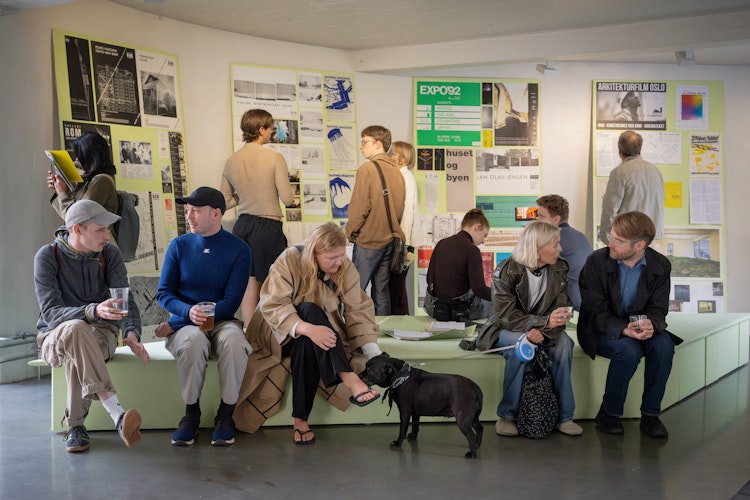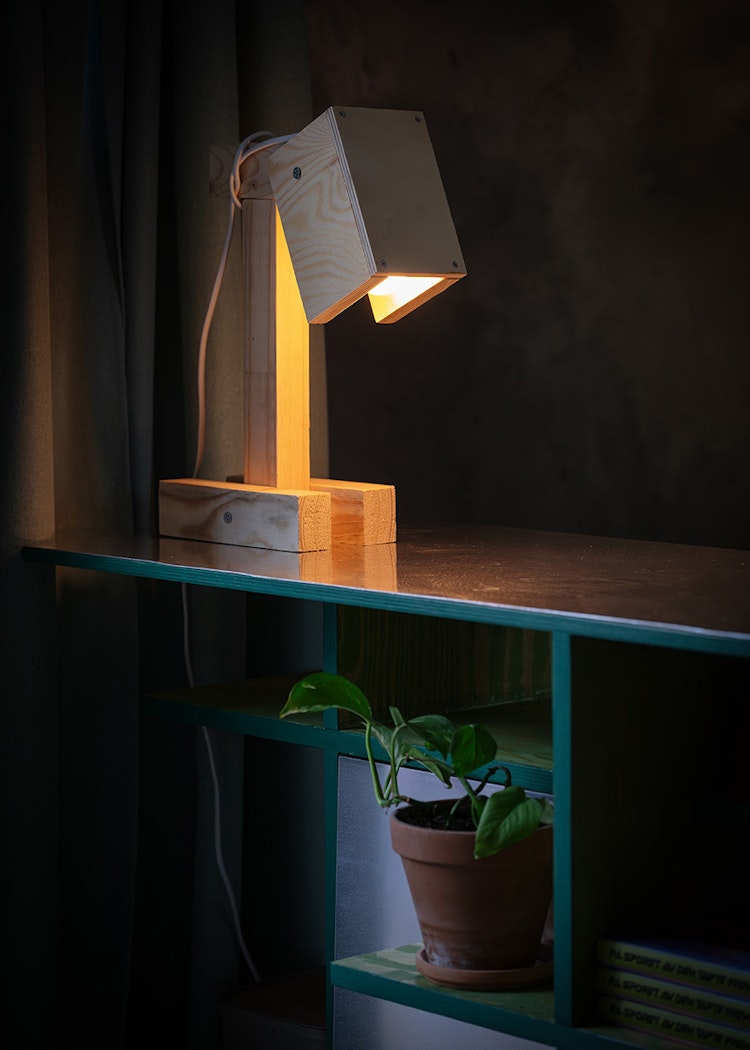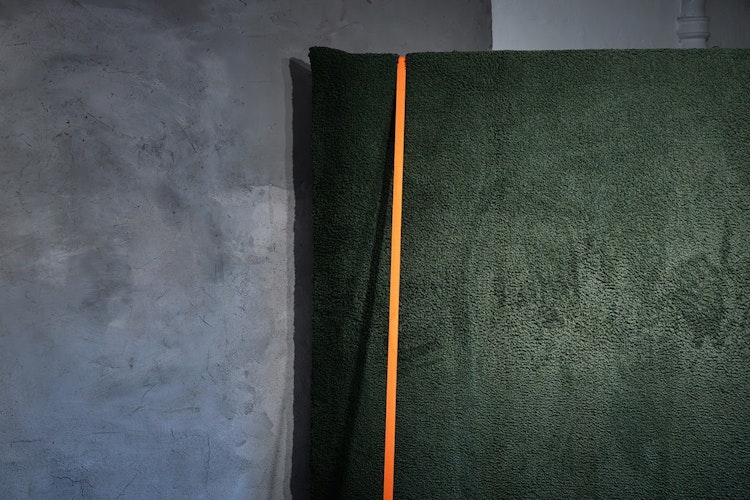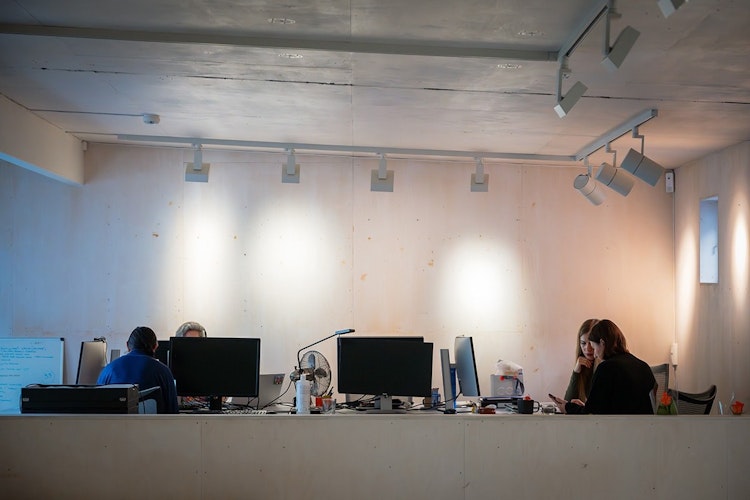The exhibition is presented through six entrances – ‘points’ – which together constitute mulighetsrommet and reflect ROM's past, ongoing experiments, and future – not as definitive answers, but as inviting questions.
Mulighetsrommet
10 - 19 October 2025
Mulighetsrommet is ROM’s anniversary exhibition for the move into Maridalsveien 3. The exhibition is not only a revisiting of the past, but also a workspace oriented toward the future. The audience is invited to take part in the processes of reading, questioning, contributing material, and testing ideas alongside us. Welcome to the space where history, practice, and possibilities meet.

Be the Ramp
Be the Ramp is an interdisciplinary project by FAT (Anja Tveiterås og Fredrik Alden Thorsen) and Enrique Roura. The installation is located outside our main entrance and is a concrete and temporary ramp – a materialised metaphor for accessibility. Be the Ramp makes thresholds and level differences physically tangible, providing a basis for discussion about dignity, sustainability, and how spaces can be altered to serve more people.
This could be permanent
In this anniversary year, Be the Ramp is functioning as part of an active laboratory: we are testing solutions for accessible design, use of materials, acoustics and entrance solutions that we believe should characterise the institutions of the future. As a prototype, the work makes architectural choices tangible and shows how inclusive and equitable solutions can take shape and be replicated elsewhere. The ambition is to make touch-free automatic doors the standard in the ‘new’ entrance — a simple, visible and important improvement for all users.
How to make an Entrance
Be the Ramp is ultimately about exclusion created by architecture in public spaces. Many buildings are technically accessible to wheelchair users, but access often requires a cumbersome process: calling staff, entering via the back entrance, or using a slow platform lift that makes the user visible on other people's terms. You get in, but at what cost? The project asks whether legal requirements are enough, or whether the quality of accessibility must also be measured by how much respect and dignity the user experiences.
ROM Studio: Mulighetsrom
In ROM Studio: Mulighetsrom, the ROM team, consisting of Armelle Breuil, Enrique Roura, Märta Carlsson, and Solveig Tjetland, has explored a different way of using the space. ROM Studio is a working exhibition where artists, architects, curators, and researchers join the ROM team for three weeks.
ROM Studio: Mulighetsrom has aimed to transform ROM's premises into a more accessible, sustainable and inclusive exhibition space and workplace. The process has been open to the public through a series of workshops where ideas have been tested in practice, using materials (recycled and residual waste) from Ombygg, the Norwegian Folk Museum - TradLab, Elements of Nature, and Thaugland. The period has included workshops by Maike Statz, Chris Millar, Trygve Ohren, and all participants have contributed to the construction: Henriette, Alexander, Lalie, Kristian, Frida, Charlotte, Justyna, Kaja, Sveinung, Frederic, Anne Line, Tina Julianne, Anna, Anastasia, Cecilia Cissi, Anne Sofie, Lene, Mari, Gjertrud, Selma, Alla, Eskild, Manon, Aleksandra, Nick, Robert, Caroline.
The result of the process has been two spatial construction projects:
I. The stairwell is separated from the rest of the premises using recycled materials, sustainable techniques, and a design that allows for dismantling. The project forms a boundary between the workshop in the basement, the exhibition areas, and the defined workspaces. Two new doors from the Rikshospitalet have been installed on both floors by the staircase, making it possible to establish two new work areas made from recycled materials – including a window table and chair on the ground floor developed from an idea by the workshop led by Maike Statz. On the first floor, a new wall with cubes and clay has been created facing the stairs, with a coat rack. Towards the gallery, recycled boards painted with homemade linseed oil have been installed.II. New reception area at the main entrance. The workspace includes a multifunctional reception desk on wheels, developed in a workshop led by ACT! and painted with homemade linseed oil. In addition, a sound-absorbing partition wall on wheels was developed in workshops led by Trygve Ohren. The partition wall can be moved and adapted, making it possible to create different spatial zones and degrees of openness. Through workshops led by Chris Miller, a clay wall was also developed, built through experimentation with clay from the Norwegian Folk Museum and various craft techniques. The wall explores how an extra surface layer can contribute to insulation against temperature and sound, while adding a tactile and sensory quality to the room. Finally, a curtain frames the work area. It functions as a room divider, sound absorber, and windbreak, marking the transition between the entrance area and the work zone.
ROM Studio is supported by Sparebankstiftelsen DNB.
The Thinking Wall after Uke 35
A collection of reflections drawing on the seminar Uke 35: the role of the master plan for small institutions, the relationship between showing and learning, and how methodological openness, experimentation, and gradual renewal can be strategies for the future. The seminar was curated by ROM's artistic director, Gjertrud Steinsvåg, and artist, architect, and curator Trygve Ohren. The Thinking Wall summarises insights and points towards further work, and welcomes further input!






2nd floor — pilot with Architects Without Boarders
From August 2025 to August 2026, Architects Without Borders (AUG) will conduct a pilot project on the second floor of ROM, investigating how shared use of the premises can create new meeting places and strengthen collaboration. The project is based on insights from the artist duo FAT's exhibition, I’m sorry if my disability causes you any inconvenience (2024) on accessibility, and reflects both opportunities and limitations. Some solutions cannot be implemented immediately due to practical, regulatory, and economic constraints, and the limited access to the second floor allows us to reflect on these challenges as part of the experiment. The pilot is experimenting with small, cost-effective measures to increase accessibility, promote collaboration, and support the long-term, inclusive development of the building.
Incomplete archive
A corner with boxes and unsorted material where ROM's own history is beginning to take shape. The archive displays fragments, invites supplementary contributions, and highlights how institutional history is an open, collective process. This is a workspace for documentation and shared memory, which questions the preservation value of this type of material.
1987–2025 (SPEED)
A mini exhibition curated in collaboration with the architectural firm SPEED (Espen Heggertveit and Eirik Stokke-Mikalsen). The mini exhibition opened in connection with our birthday party on 5 June. It displays selected documents, photographs, and texts that point to ROM's roots in Galleri ROM and the Institute for romkunst — and further into today's practice.

ROM 20 år, foto av Carsten Aniksdal.
The process behind the exhibition has developed through several phases: an idea development phase in 2024, and a two-day insight workshop in spring 2025 with invited contributors from the fields of art, architecture and accessibility; ROM Studio Mulighetsrom, a working exhibition and pilot period this autumn, where interventions were carried out and tested in real time; and seminars and anniversary celebrations that have shaped the themes and priorities of the project. The work reflects ROM's role as a laboratory: a place for experimentation, interdisciplinary dialogue, and long-term, value-driven production and dissemination.

Mulighetsrommet (2025), exhibition. Photo: ROM

Mulighetsrommet (2025), exhibition. Photo: ROM

Mulighetsrommet (2025), exhibition. Photo: ROM

Mulighetsrommet (2025), exhibition. Photo: ROM

Mulighetsrommet (2025), exhibition. Photo: ROM

Mulighetsrommet (2025), exhibition. Photo: ROM

Mulighetsrommet (2025), exhibition. Photo: ROM

Mulighetsrommet (2025), exhibition. Photo: ROM

Mulighetsrommet (2025), exhibition. Photo: ROM

Mulighetsrommet (2025), exhibition. Photo: ROM

Mulighetsrommet (2025), exhibition. Photo: ROM

Mulighetsrommet (2025), exhibition. Photo: ROM

Mulighetsrommet (2025), exhibition. Photo: ROM

Mulighetsrommet (2025), exhibition. Photo: ROM

Mulighetsrommet (2025), exhibition. Photo: ROM

Mulighetsrommet (2025), exhibition. Photo: ROM


